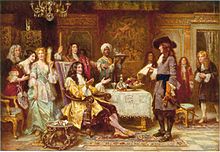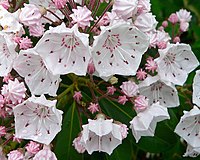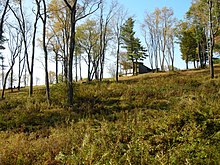The Pennsylvania Portal Pennsylvania (/ˌpɛnsɪlˈveɪniə/ ⓘ PEN-sil-VAY-nee-ə, lit. 'Penn's forest'), officially the Commonwealth of Pennsylvania (Pennsylvania Dutch: Pennsylvanie), is a state spanning the Mid-Atlantic, Northeastern, Appalachian, and Great Lakes regions of the United States. Pennsylvania borders Delaware to its southeast, Maryland to its south, West Virginia to its southwest, Ohio and the Ohio River to its west, Lake Erie and New York to its north, the Delaware River and New Jersey to its east, and the Canadian province of Ontario to its northwest. Pennsylvania is the fifth-most populous state in the United States, with over 13 million residents as of the 2020 United States census. The state is the 33rd-largest by area and has the ninth-highest population density among all states. The largest metropolitan statistical area (MSA) is the southeastern Delaware Valley, which includes and surrounds Philadelphia, the state's largest and nation's sixth-most populous city. The second-largest metropolitan area, Greater Pittsburgh, is centered in and around Pittsburgh, the state's second-largest city. The state's subsequent five most populous cities are Allentown, Reading, Erie, Scranton, and Bethlehem. The state capital is Harrisburg. Pennsylvania's geography is highly diverse. The Appalachian Mountains run through the center of the state; the Allegheny and Pocono mountains span much of Northeastern Pennsylvania; close to 60% of the state is forested. While it has only 140 miles (225 km) of waterfront along Lake Erie and the Delaware River, Pennsylvania has the most navigable rivers of any state in the nation, including the Allegheny, Delaware, Genesee, Ohio, Schuylkill, Susquehanna, and others. (Full article...) This is a Featured article, which represents some of the best content on English Wikipedia..
Taylor Alison Swift (born December 13, 1989) is an American singer-songwriter. A subject of widespread public interest, she has influenced the music industry and popular culture through her artistry, songwriting, and entrepreneurship. She is an advocate of artists' rights and women's empowerment. Swift began professional songwriting at age 14. She signed with Big Machine Records in 2005 and achieved prominence as a country pop singer with the albums Taylor Swift (2006) and Fearless (2008). Their singles "Teardrops on My Guitar", "Love Story", and "You Belong with Me" were crossover successes on country and pop radio formats and brought Swift mainstream fame. She experimented with rock and electronic styles on her next albums, Speak Now (2010) and Red (2012), respectively, with the latter featuring her first Billboard Hot 100 number-one single, "We Are Never Ever Getting Back Together". Swift recalibrated her image from country to pop with 1989 (2014), a synth-pop album containing the chart-topping songs "Shake It Off", "Blank Space", and "Bad Blood". Media scrutiny inspired the hip-hop-influenced Reputation (2017) and its number-one single "Look What You Made Me Do". (Full article...)Selected geography article -Pithole, or Pithole City, is a ghost town in Cornplanter Township, Venango County, Pennsylvania, United States, about 6 miles (9.7 km) from Oil Creek State Park and the Drake Well Museum, the site of the first commercial oil well in the United States. Pithole's sudden growth and equally rapid decline, as well as its status as a "proving ground" of sorts for the burgeoning petroleum industry, made it one of the most famous of oil boomtowns. Oil strikes at nearby wells in January 1865 prompted a large influx of people to the area that would become Pithole, most of whom were land speculators. The town was laid out in May 1865, and by December was incorporated with an approximate population of 20,000. At its peak, Pithole had at least 54 hotels, 3 churches, the third largest post office in Pennsylvania, a newspaper, a theater, a railroad, the world's first pipeline and a red-light district "the likes of Dodge City's." By 1866, economic growth and oil production in Pithole had slowed. Oil strikes around other nearby communities and numerous fires drove residents away from Pithole and, by 1877, the borough was unincorporated. (Full article...)Selected image - Credit: Phillyfan0419 Citizens Bank Park is a 43,647-seat baseball-only stadium and home to the Philadelphia Phillies. Did you know -
Related portalsWikiprojectsThis is a Good article, an article that meets a core set of high editorial standards.
Elizabethtown station is an Amtrak railroad station on the Keystone Corridor in Elizabethtown, Lancaster County in the U.S. state of Pennsylvania. The station is served by Amtrak's Keystone Service between New York City and Harrisburg, and by the Pennsylvanian between New York and Pittsburgh. The station was built in 1915 by the Pennsylvania Railroad to replace another that had been built in 1900. The station building was closed in 1977 by Amtrak. The title to the building was transferred to the borough of Elizabethtown in 1998, and it was leased back to Amtrak. From 2009 to 2011, the station underwent a 21-month renovation to make it handicapped-accessible. (Full article...) Selected article - The history of Pennsylvania stems back thousands of years when the first indigenous peoples occupied the area of what is now Pennsylvania. In 1681, Pennsylvania became an English colony when William Penn received a royal deed from King Charles II of England. Although European activity in the region precedes that date (the area was first colonized by the Dutch in 1643). The area was home to the Lenape, Susquehannocks, Iroquois, Erie, Shawnee, Arandiqiouia, and other American Indian tribes. Most of these tribes were driven off or reduced to remnants as a result of diseases, such as smallpox. The English took control of the colony in 1667. In 1681, William Penn, a Quaker, established a colony based on religious tolerance; it was settled by many Quakers along with its Philadelphia, its largest city, which was also the first planned city. In the mid-1700s, the colony attracted many German and Scots-Irish immigrants. (Full article...)Pennsylvania news
CategoriesState factsState Facts
State symbols
Pennsylvania topicsGeneral imagesThe following are images from various Pennsylvania-related articles on Wikipedia.
Associated WikimediaThe following Wikimedia Foundation sister projects provide more on this subject:
Discover Wikipedia using portals
|

Sons of Union Veterans of the Civil War

































































